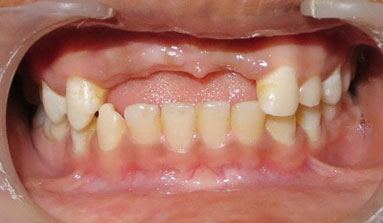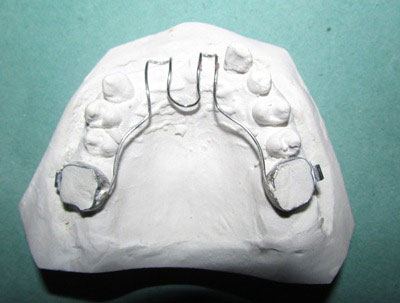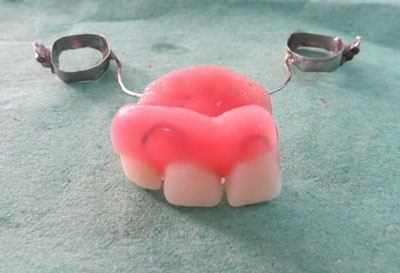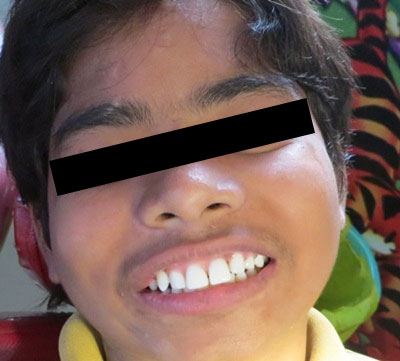Frog Appliance- An Innovative Treatment Option for the Replacement of Missing Teeth in An Epileptic Child
Raghavendra M Shetty1, Anita Goyal2, Hanumanth Reddy3, Arun B Sajjnar4, Sonal Jain5
1 Professor and Head of the Department, Department of Pedodontics and Preventive Dentistry, Chhattisgarh Dental College and Research Institute, Rajnandgaon, Chhattisgarh, India.
2 PG student, Department of Pedodontics and Preventive Dentistry, Chhattisgarh Dental College and Research Institute, Rajnandgaon, Chhattisgarh, India.
3 Professor and Head of Department, Department of Orthodontics, Chhattisgarh Dental College and Research Institute, Rajnandgaon, Chhattisgarh, India.
4 Reader, Department of Pedodontics and Preventive Dentistry, Chhattisgarh Dental College and Research Institute, Rajnandgaon, Chhattisgarh, India.
5 Senior Lecturer, Department of Pedodontics and Preventive Dentistry, Chhattisgarh Dental College and Research Institute, Rajnandgaon, Chhattisgarh, India.
NAME, ADDRESS, E-MAIL ID OF THE CORRESPONDING AUTHOR: Dr. Raghavendra M Shetty, Professor and Head of the Department, Department of Pedodontics, Chhattisgarh Dental College and Research Institute, Rajnandgaon– 491 441, Chhattisgarh, India. E-mail : raghavendra77@yahoo.com
Epilepsy is a chronic neurological disease which may result in various oro-facial injuries among which fracture of crown and avulsion of tooth are commonly reported. Challenges come in growing epileptic children where fixed prosthesis could not be delivered and it demands a fixed semi-permanent prosthesis that needs strength along with esthetics. The present paper reports an innovative appliance which has fulfilled fore mentioned criteria; with the appliance named-frog appliance.
Avulsion, Neurological disorder, Semi-permanent bridge
Case Report
A 14-year-old boy accompanied by his father reported to the Department of Pedodontics and Preventive Dentistry, with the chief complaint of missing upper front teeth due to a fall two days back. History revealed that the child was a diagnosed epileptic patient and was under carbamazepine (100 mg t.d.s) since five years. Parent reported that the child had a fall two days back due to epileptic attack and was unconscious for 30-40 sec. Loss of teeth with a cut on the labial mucosa was noticed. However, no attempt to find the lost teeth on the ground was made. On examination, the face was bilaterally symmetrical with minor injuries on lips were present. Intraoral examination revealed missing 11, 12 and 21 [Table/Fig-1]. Intraoral periapical radiograph showed no tooth/root fragments in the socket and diagnosis of avulsion was confirmed. Palpation of lips and buccal mucosa revealed no tooth/tooth fragments embedded. The initial treatment included irrigation of the socket with betadine, suturing and prescription of antibiotics and analgesics. The procedures were performed taking into consideration the protocols which would not trigger the epileptic attack of the patient. Dental procedures were explained to the child before initiating the treatment to reduce the apprehension and at the same time psychological assurance was given to the child thereby reducing the anxiety of the child. The light was focused in such a way that, it did not flash on to the patients eyes as that could trigger the seizure. Precautions were taken with respect to the instruments kept at the periphery of the patient. Next appointment was planned after 15 days in the morning hours since that is the safest time and minimal risk of seizures are supposed to happen. Patient was instructed to have his medications prior to the appointment and follow his regular regimen. During the second appointment (i.e. after 15 days) a proper healing of the socket with complete closure of the wound was seen. Thereafter oral prophylaxis was carried out.
Intraoral photograph showing missing 11, 12 and 21

An innovative fixed semi-permanent bridge coined as “frog appliance” was planned as a treatment modality and treatment plan was discussed with patient’s physician taking patient’s safety into consideration. Hence, band adaptation was done in relation to 16 and 26 and impression was made and the bands were transferred into the impression, stabilized and poured with dental stone. Cast was obtained with bands incorporated in relation to 16 and 26.
Fabrication of the Frog appliance
A 0.8 mm stainless steel wire was used to fabricate the appliance. The wire component consisted of anterior part and a posterior part. Anterior part extended facially and palatally along the alveolar ridge. The posterior part which was in the continuation of the anterior part extended distally along the alveolus on the both sides up to middle third of the band adapted on the first molars. This particular innovative wire component gave an appearance of a frog [Table/Fig-2].
Innovative wire component giving an appearance of a frog

Acrylic teeth were selected for the shape, size and shade. Anterior component of frog appliance was covered with self-cure acrylic and the selected acrylic teeth were arranged for esthetics. After acrylization the appliance was finished polished [Table/Fig-3] and was delivered to the patient [Table/Fig-4].
Teeth arrangement and acrylization of the appliance

Appliance in the patient mouth

Follow up after 8 months showed greater patient acceptability and the appliance was intact though the patient had seizures during this span of time as reported by the parents.
Discussion
Epilepsy is the name of a brain disorder characterized predominantly by recurrent and unpredictable interruptions of normal brain function, called epileptic seizures. Epilepsy is not a singular disease entity but a variety of disorders reflecting underlying brain dysfunction that may result from many different causes [1]. Injuries to the face and teeth are more common in patients with epilepsy than in the general population, and the individuals who suffer seizures without aura are the most affected. The prevalence of oro-facial trauma in children is 4.4% whereas; in epileptic patients it was found to be 23.9% [2]. The commonest lesions are fractures of dental tooth crowns (32.9%), followed by tooth avulsion (7.6%), tooth luxation (5%) and fracturing of prostheses in edentulous patients (3.8%) [2].
Loss of teeth not only interferes with the patients function and esthetic but also impairs the personality. Loss of teeth also promotes tongue thrusting in the child. This problem can be managed in several ways like auto-transplantation [3,4], orthodontic space closure [5], implant treatment [6,7], and the prosthetic rehabilitation as removable functional space maintainer. In this case, replantation of teeth was not possible as patient failed to find his missing teeth; implant was not possible because of the poor financial condition which could limit its use for the replacement of three missing tooth. Removable functional space maintainer could not be planned as the patient was known case of epilepsy, so during the epileptic attack the prosthesis could block the airway. Definitive therapy could not be planned since the patient is still in his growth phase and has to be replaced in future. Hence, a provisional treatment which was more economical and acceptable with minimal interference with growth was planned for the replacement of missing teeth.
The technique describes a new treatment option for the replacement of a missing anterior tooth. Similar type of fixed semi- permanent prosthesis was given by many authors. Sharma et al., had utilized an avulsed tooth as a pontic and incorporated in a space maintainer. The brackets were attached to the palatal portion of the avulsed, natural teeth with light cured composite resin [8]. The esthetic consideration of this appliance was acceptable though this point of attachment of the bracket cannot withstand the epileptic forces. Guler and Yilmaz had used a 0.9mm round orthodontic wire which was bent to follow the palatal aspect of the maxillary teeth, with an intricate loop bent over the extraction site for acrylic retention [9]. This appliance did not have the buccal extention which was a limitation to be used for an epileptic child as the force dissipated would not have been uniform leading to the fracture of the appliance or other complications. Paul et al., demonstrated similar type of appliance but the wire component was not extended to labial surface of alveolus making the appliance more vulnerable to fracture during seizure [10]. Ganesh et al., concluded that ribbond can be the material of choice for space maintainer as this procedure requires lesser laboratory work and can be delivered in single appointment [11]. However, Kirzioglu and Erturk evaluated the success rate of reinforced fiber material space maintainers and concluded that this appliance would be successful if given only for a shorter period of time, as majority of the fiber reinforced space maintainers were dislodged by the end of the sixth month [12].
But in this case apart from esthetics; strength of appliance was also one of the major criteria as it had to bear the pressure of opposing arch during the epileptic attack of the child. Therefore, a newer design wire component was incorporated into the appliance such that it increases the strength of acrylic both facially and lingually. This fixed-interim prosthesis can be considered as a non-invasive and long-term provisional treatment, while providing superior esthetics, strength and function, the cost effectiveness of this technique made it superior to all other options. It is more comfortable for the young patient than a removable appliance. It does not require any tooth reduction and can be easily modified or repaired by simple chairside procedures, until the time a more definitive restoration can be placed. This appliance is also of great psychological benefit to the child and adds to his self-esteem.
Conclusion
Treating growing epileptic child still remains a challenge for the Pedodontist. As these children are more prone for the oro-facial trauma, the treatment for epileptic child should be more thoughtful taking care of not only their function and esthetics but to a larger extent their safety during the attacks. Treatment options for such patients still are very scanty and this appliance till a greater extent takes care of all the above mentioned criteria because of the following advantages:
Wire component covering both facial as well as lingual aspect of anterior alveolar ridge, thereby increasing the strength and durability of the appliance as it is the main pressure bearing area during the seizures.
Non-invasive long term provisional treatment, providing superior esthetics, strength and function.
Simple and decreased chair side procedure, thereby giving lesser stress to the epileptic child.
Fixed appliance which will not interfere with the respiration during the seizures.
Not much economic burden to the patient.
[1]. Fisher S, Boas WE, Blume W, Epileptic seizures and epilepsy: definitions proposed by the International League against Epilepsy (ILAE) and the International Bureau for Epilepsy (IBE)Epilepsia 2005 46:470-72. [Google Scholar]
[2]. Nonato ER, Borges MA, Oral and maxillofacial trauma in patients with epilepsy prospective study based on an outpatient populationArq Neuropsiquiatr 2011 69(3):491-95. [Google Scholar]
[3]. Slagsvold O, Bjercke B, Applicability of autotransplantation in cases of missing upper anterior teethAm J Orthod 1978 74:410-21. [Google Scholar]
[4]. Kristerson L, Lagerstrom L, Autotransplantation of teeth in cases with agenesis or traumatic loss of maxillary incisorsEur J Orthod 1991 13:486-92. [Google Scholar]
[5]. Stenvik A, Zachrisson BU, Orthodontic closure and transplantation in the treatment of missing anterior teeth: An overviewEndod Dent Traumatol 1993 9:45-52. [Google Scholar]
[6]. Kohavi D, Dikapua L, Rosenfeld P, Tarazi E, Dental implants following trauma in young adultsRefuat Hapeh Vehashinayim 2003 20:70-78. [Google Scholar]
[7]. Rossi E, Andreasen JO, Maxillary bone growth and implant positioning in a young patient: a case reportInt J Periodontics Restorative Dent 2003 23:113-19. [Google Scholar]
[8]. Sharma U, Garg AK, Gauba K, An interim fixed prosthesis using natural tooth crown as a ponticContemp Clinic Dent 2010 1(2):130-32. [Google Scholar]
[9]. Guler C, Yilmaz Y, Provisional Restoration of Anterior Edentulous Space using Extracted Primary teeth Crowns in a Fixed Appliance After Dental Trauma: A Case ReportInonu University Saglik Bilimleri Dergisi 2012 2:53-56. [Google Scholar]
[10]. Chalakkal P, Devi RS, Srinivas GV, Venkataramana P, Fixed Dentulous Appliance for Upper Anterior Edentulous SpanJ Clin Diagn Res 2013 7(12):3086-87. [Google Scholar]
[11]. Ganesh M, Tandon S, Versatility of ribbond in contemporary dental practiceTrends Biomater Artif Organs 2006 20:53-58. [Google Scholar]
[12]. Kirzioglu Z, Erturk MOS, Success of Reinforced Fiber Material Space MaintainersJ Dent Child 2004 71(2):158-62. [Google Scholar]